#three cases of murder 1955
Text

Agatha Christie Books in Order.
Hercule Poirot Books
Hercule Poirot Collections
Miss Marple Books
Miss Marple Collections
Tommy and Tuppence Books
Tommy and Tuppence Collections
Superintendent Battle Books
Standalone Novels
Short Story Collections
Non-Fiction Books
Agatha Christie Hercule Poirot books in order
Here are the names of Agatha Christie’s Hercule Poirot books in order. It will help you start with your reading while ensuring the best experience.
The Mysterious Affair at Styles (1920)
The Murder on the Links (1923)
The Murder of Roger Ackroyd (1926)
The Big Four (1927)
The Mystery of the Blue Train (1928)
Peril at End House (1932)
Lord Edgware Dies (1933)
Murder on the Orient Express (1934)
Three Act Tragedy (1935)
Death in the Clouds (1935)
The A.B.C. Murders (1936)
Murder in Mesopotamia (1936)
Cards on the Table (1936)
Dumb Witness (1937)
Death on the Nile (1937)
Appointment with Death (1938)
Hercule Poirot’s Christmas (1938)
One, Two, Buckle My Shoe (1940)
Sad Cypress (1940)
Evil Under the Sun (1941)
Five Little Pigs (1942)
The Hollow (1946)
Taken at the Flood (1948)
Mrs. McGinty’s Dead (1952)
After the Funeral (1953)
Hickory Dickory Dock (1955)
Dead Man’s Folly (1956)
Cat Among the Pigeons (1959)
The Clocks (1963)
Third Girl (1966)
Hallowe’en Party (1969)
Elephants Can Remember (1972)
Curtain (1975)
The Monogram Murders (2014)
Agatha Christie Hercule Poirot Collections in Order
Poirot Investigates (1924)
Murder in the Mews (1937)
The Labours of Hercules (1947)
Poirot’s Early Cases (1974)
Agatha Christie Miss Marple Books in Order
Here is the list of Agatha Christie’s books in order based on their publication date.
The Murder at the Vicarage (1930)
The Body in the Library (1942)
The Moving Finger (1942)
A Murder is Announced (1950)
They Do It with Mirrors (1952)
A Pocket Full of Rye (1953)
4:50 From Paddington (1957)
The Mirror Crack’d (1962)
A Caribbean Mystery (1964)
At Bertram’s Hotel (1965)
Nemesis (1971)
Sleeping Murder (1976)
Agatha Christie Miss Marple Collection in Order
The Thirteen Problems (1932)
Miss Marple’s Final Cases (1979)
Agatha Christie’s Tommy and Tuppence Books in Order
Here’s the list of Agatha Christie Tommy and Tuppence Books in Order
The Secret Adversary (1922)
N or M? (1941)
By the Pricking of My Thumbs (1968)
Postern of Fate (1973)
Agatha Christie’s Tommy and Tuppence Collections in Order
Partners in Crime (1929)
Agatha Christie’s Superintendent Battle Books in Order
Here’s the list of Agatha Christie Superintendent Battle Books in Order
The Secret of Chimneys (1925)
The Seven Dials Mystery (1929)
Cards on the Table (1936)
Murder is Easy (1939)
Towards Zero (1944)
Agatha Christie’s Standalone Novels in Order
Here’s the list of Agatha Christie Standalone Novels in Order
The Man in the Brown Suit (1924)
Giant’s Bread (1930)
The Sittaford Mystery (1931)
Unfinished Portrait (1934)
Why Didn’t They Ask Evans? (1934)
And Then There Were None (1939)
Absent in the Spring (1944)
Death Comes as the End (1944)
Sparkling Cyanide (1945)
The Rose and the Yew Tree (1948)
Crooked House (1949)
They Came to Baghdad (1951)
A Daughter’s a Daughter (1952)
Destination Unknown (1954)
The Burden (1956)
Ordeal by Innocence (1958)
The Pale Horse (1961)
Endless Night (1967)
13 at Dinner (1969)
Passenger to Frankfurt (1970)
The Murder at Hazelmoor (1984)
Agatha Christie’s Short Story Collections in Order
Here’s the list of Agatha Christie Short Story Collections in Order
The Mysterious Mr. Quin (1930)
The Hound of Death (1933)
The Listerdale Mystery (1934)
Parker Pyne Investigates (1934)
The Regetta Mystery and Other Stories (1939)
The Witness for the Prosecution and Other Stories (1948)
Three Blind Mice and Other Stories (1950)
The Under Dog and Other Stories (1951)
The Adventure of the Christmas Pudding (1960)
Double Sin and Other Stories (1961)
Star Over Bethlehem and Other Stories (1965)
The Golden Ball and Other Stories (1974)
The problem at Pollensa Bay and Other Stories (1991)
The Harlequin Tea Set (1997)
While the Light Lasts and Other Stories (1997)
Agatha Christie’s Non-Fiction Books in Order
Here’s the list of Agatha Christie Non-Fiction Books in Order
Come, Tell Me How You Live (1946)
Agatha Christie: An Autobiography (1977)
Top 10 Agatha Christie Books to Read
Given the number of books in the Agatha Christie series, readers generally hesitate to begin. Further, to understand the series well, one needs to read Agatha Christie’s novels in order. To ease things, the readers generally look for the best novels or books to read them directly and avoid all the hassle. So here are the top 10 Agatha Christie novels that will offer you the best mystery story reading experience.
#agatha christie#poirot#hercule poirot#miss marple#tommy and tuppence#superintendent battle#literature#english literature#books#classics#crime novles#1920s#1930s#1940s#1950s#1960s#1970s#vintage
77 notes
·
View notes
Text
Spooky season fairytales (7)
And finally, my last "spooky season" post! With seven posts of movie (and series and books) recommandations, plus additional reblogs, you'll have plenty on your plate for this Halloween!
And for this final post, I will go into the world of horror movies. I am here speaking of pure horror movies - not fairytale movies, not dark fantasy movies... BUT! Horror movies that were inspired by or heavily references fairytales.
Let us begin with a classic of classics when it comes to fairytale horror:
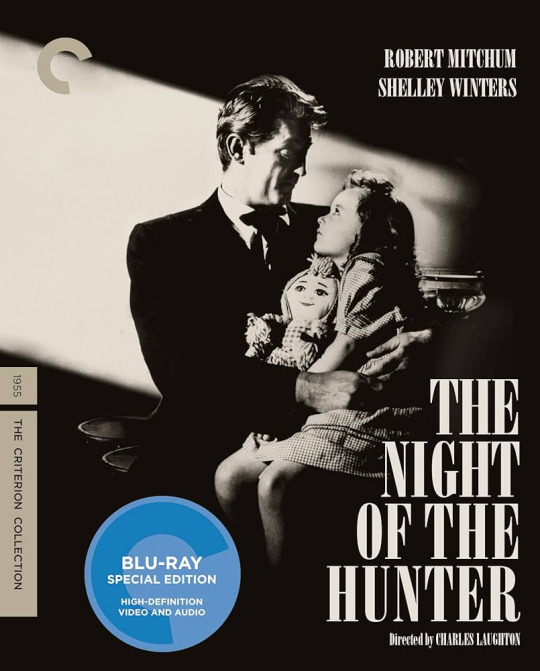
The Night of the Hunter, the 1955 classic movie. While technically not a horror movie per se, as many call it a "thriller" or a "film noir", it is very close to the horror world, and it heavily draws from fairytales!
Everybody knows by now the plot of this famous masterpiece. Black-and-white, heavily drawing from the silent movie era, "The Night of the Hunter" tells the story of how a dangerous serial-killer pretending to be a preacher worms his way into the household of a widow and her two children, hoping to find the money the deceased husband had hidden... As he kills the mother, the two children have to escape his clutches and wander throughout the American countryside in search of a new hope, while being hunted down by the evil figure...
When Charles Laughton decided to adapt the novel this movie was based off, he called it a "nightmarish mother Goose story". And, faithful to this description, he made sure his movie would be a dark Mother Goose fairytale. A tragic family drama forcing children to flee through the wilderness... Young ones fleeing from their wicked step-father, and seeking comfort in a kind grandmother-figure... A dark story filled with threats and creepy sights that ultimately ends well... Most significantly, the antagonist of the story, Harry Powell, played by Robert Mitchum, is actually designed to be the fusion of all three most famous male antagonists in Perrault's fairytales.
As a sinister serial killer who murders his new wife in a story about greed, he is Bluebeard. As a monstrous father-figure who hunts down two children across the wilderness to kill them, he is the Ogre. And finally, he is the Big Bad Wolf - but in this case the references are more to the early 20th century cartoons involving the character, since some of the mannerism of the villain, coupled with dark-humor slapstick scenes, clearly evoke the cartoonish Big Bad Wolf one can see in pieces such as Disney's Little Pigs cartoons.
Overall, this movie would be best described as a "realistic take on Perrault's fairytales". Remove the magic and the intemporal nature, and you've got this story.
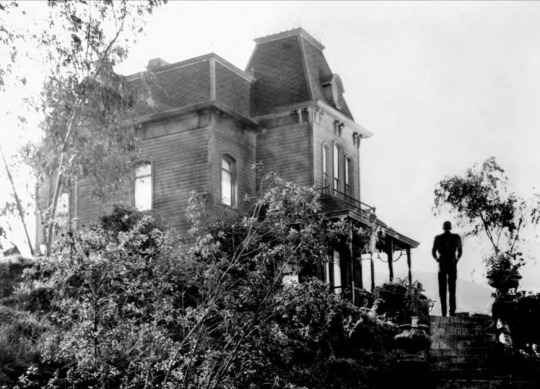
Psycho, the 1960 classic of Hitchcock, also deserves to be on this list. Just like "The Night of the Hunter", it is another black-and-white, stylized thriller-movie about a serial killer, adapted from a novel it overshadowed. But whereas Night of the Hunter was purposefully designed as a fairytale, Psycho has little to do with it.
So why is Psycho on this list? Because while it wasn't designed as a fairytale piece, it ended up being a "fairytale horror movie". You see, many before me have pointed it out and analyzed it, but "Psycho" reuses a setting, a plot and characters that are eerily similar if not completely parallel to fairytales. The most notorious example is that Psycho is usually called a "modern Bluebeard". Indeed, we are yet again dealing with a male figure murdering women in the context of romantic/erotic relationships, and a forbidden room (well, a forbidden house) hiding a female corpse... [Note: Given Psycho's huge success, I do not think I need to put spoilers warnings]. In a lesser way, Psycho can also be read as a retelling of Little Red Riding Hood. A charming male figure seemingly harmless and playful charms women... only for them to end up being murdered. The erotic undertones and the fact the male murderer little dresses as an old woman accentuates the Little Red Riding Hood parallels.
But more generally, one can tie up this movie with a lot of fairytales that all share the similar canvas of - the seemingly sweet young man is a murderer killing women (for example Grimm's The Robber Bridegroom, which also has an elderly mother-ifugre), or the mother-in-law is a deadly antagonist (the second part of Sleeping Beauty where the prince's ogress-mother wants to kill Sleeping Beauty).

The Texas Chainsaw Massacre sees us leave the world of more "quiet" and "suggestive" black and white movie for the gritty, disturbing, repulsive and yet morbidly poetic and nightmarishly oniric world of... what stood between the slasher-to-be-coded and the redneck-horror-yet-to-be-created.
Did you know that this movie began as a Hansel and Gretel project? Oh yes! It all started out with a project to make a movie out of Hansel and Gretel, a dark and adult movie. As this project was settled, the influence of "Night of the Living Dead" reshaped the creation, and an attempt at re-creating the feeling of this movie was worked on... Then it was just a question of adding disturbing real-life facts, from the social rot of the Rust Belt to the life of Ed Gein, and you've got this classic of horror. The Hansel and Gretel origins of the movie still remain - the heavy topics of food and cannibalism, the treatment of young adults as cattle, teenagers being lured into the depths of the woods to a seemingly peaceful but in fact deadly house... You can also read in it a dark retelling of "Goldilocks and the Three Bears". Youth enters an unknown house uninvited and must flee when the three beasts that inhabit it come home... Except the beasts are here human serial-killers.
But the thing that should be highlighted with this movie is that... Despite being a disturbingly realistic piece with no actual magic or fantasy in it - it is the story of disturbed, mentally-ill serial killers in the depths of the dying American South - this movie has something magical to it. Or maybe "eldritchian". Most people agree that this is an actual Southern Gothic movie, and there was a fascinating video essay on Youtube about the cosmic horror aspect of this movie, and some would even classify it as a "folk-horror" piece... And there's a reason to all that.
Once again, this is probably due to the original direction of the movie as an "Hansel and Gretel" story, but despite being a "realistic" piece, the movie makes itself oniric and unreal. It uses very simplified and thus symbolic presentations and framings of the world that evoke this dark fairytale feeling - the clear cut between night and day, the unfolding of the story between a sunset and a sunrise, the limited locations that are the road - the house - the woods. There is a true "passage into the Otherworld" as the characters leave the sane, rational, civilized and human side of Texas to enter the disturbed, insane, monstrous and nocturnal domain of the antagonists, where very human taboo is systematically broken. There is something very Lovecraftian in the madness and degenerescence presented here by the murderous family, which adds to the "cosmic horror/eldritch horror" feeling when you consider the ritualistic way the various murder and grave-robbings are performed, and the extremes nature imposes on the character (scorching hot sun, pitch-black night), and the astrological foreshadowings...
Finally, the antagonists themselves are just fairytale monsters. They are modern ogres, human yet monstrous dwellers of the desert woods, beast-like man-eaters all too disturbingly human. They are the robbers killing and eating people in the woods from the Robber Bridegroom. And while they are "realistic", as in they are just insane and (possibly) inbred serial-killers, there is so much mystery left around them that they become almost supernatural. We never know their names. We never know their exact relationships to one another. We never exactly know where they came from and how they came to be as such. Just like the monstrous families of trolls and giants in fairytales, they just happen to be here, and are just known by their role. And of course, the presence of the vampiric impossibly-still-alive grandpa adds the final touch to the nightmare that truly breaks off from reality into the full uncanny valley of the fantastic in its literary sense.
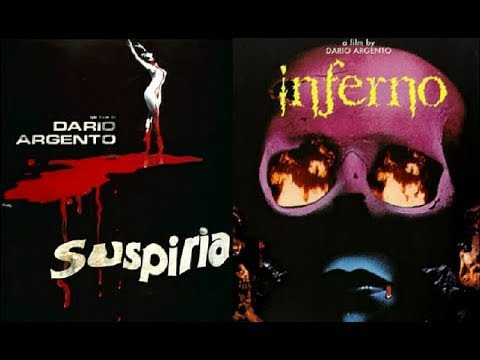
Two for the price of one! Dario Argento's duology of "Suspiria" and "Inferno". (Yes there is a third movie forming a trilogy, "Mother of Tears" or "The Third Mother", but we will NOT talk about it).
These movies are staples of Italian horror, of the supernatural side of the giallo genre, and of witch horror movies in general. Suspiria is now a well known classic : a young American girl gets enroled into a German dancing school, but strange events, mysterious disappearances and gruesome murders led her to invastigate strange, eerie and oniric conspiracies - with the final twist (now what the movie is famous for) being that a witch coven is located in the school and killing people in their occult rites. Inferno, the sequel, deepens the mythology brought in Suspiria: after his sister mysteriously disappears in a New-York building, a young man comes to investigate the reason she was so afraid recently. A book about the existence of three evil witches hiding their dark magic within three different buildings - and the one the young man's sister lived in might have been one of those buildings...
These two movies follow the typical codes of the giallo (bloody murders with intentionally-unrealistic effects perpetuated by masked assaillants with a whodunnit structure), while having Argento's typical touch (the use of unnatural red, blue, green and yellow lights giving the whole movie a surrealistic and oniric tone, very unique soundtrack choices), and ultimately delve into occult and esoteric horror as they are filled with a web of evil witches, human sacrifices, deadly curses and terrifying undeads, all inspired by the Three Mothers invented by Thomas de Quincey.
However another very important if not fundamental aspect of Suspiria should not be ignored: it is a Snow-White movie. One thing that tends to confuse people when watching Suspiria is why women in their 20s such as the protagonists are acting extremely childish. The answer: they were supposed to be children. The movie was originally written to have a child protagonist, and all the students in the dance school being children - but since the murder of children as a no-no in 70s Italy, it was decided to make them adult... However Argento wanted to make a horror version of Snow-White, about an old witch targetting and murdering young girls to gain more power. So what he did was keep the original dialogues, and then create a strange set where everything was of the wrong size - too great, too tall, too big, with for examples door handles at the level of people's chests rather than hands - to have the adult protagonist look and feel like a child inside this strange academy. More obviously, Argento heavily references Disney's Snow-White in his movie - from the use of heavily saturated colors and of extremely unique, colorful, almost surreal architecture, to the presence of a neon-glass peacock in the witch's lair designed after the peacock motif of Disney's Evil Queen.
Inferno, the sequel, as a continuation of Suspiria, also has a basis and roots in a fairytale - this time Hansel and Gretel. But the references are more sparse and trivial than in Suspiria, where the fairytale theme was very present. You have a sister and a brother lured into a witch's house ; it is strongly implied if not outright confirmed that the witch's coven are cannibals ; and the movie ends up with the witch burning down. But beyond that, Argento wanted to focus much more on the "Three Mothers" mythology than to make a true fairytal rewriting.
[A warning: if you want to watch Inferno there are depictions of animal abuse. So be warned, it isn't for animal-lovers. Well the guy who performs the animal abuse gets brutally murder as a consequence, but still.]

"The Shining" is one of my favorite horror stories, and I am the first to admit it isn't a fairytale story at all. It is a familial tragedy about alcohlism, isolation and domestic abuse, interwoven with the supernatural story of a little kid with powerful psychic abilities being targetted by the ghosts and demonic entities inhabiting an hotel symbolizing all that was corrupted and wrong with upper-class 20th century USA... And the movie is certainly one of the best horror movies of the second half of the 20th century.
But there is something in Stanley Kubrick's movie that is not present in Stephen King's novel. Or rather it is present in just a few lines of the entire novel, and Kubrick had the great idea of expanding it as a recurring underlying, secondary theme... Fairytale references.
People have already written articles about it, but Stanley Kubrick decided to insist and even add fairytale references across his movie, so that, when you decide to look at the story under a certain angle, you realize there is a "dark fairytale" undertone to it. Of course, the famous behavior of insane-Jack as the Big Bad Wolf from the Three Little Pigs, with explicit references, comes to mind. But there's also the fact that The Shining is a familial tragedy about a parent figure becoming a monstrous threat - something very common of fairytales. The supernatural notably acting by having warning messages coming from nowhere and previous victims appear to the future ones recall of how in fairytales involving murderers (like Bluebeard variants, or The Robber Bridegroom, and other variants) there will always be disembodied voices, or ghost of previous victims, or talking trees warning the protagonist. And the line of Wendy evoking "breadcrumbs" to find her way through the kitchen is working with numerous other elements of the story: the labyrinthic Overlook Hotel works as the forest in which children or girls get lost ; there is the same clear rich vs poor plenty vs hunger dichotomy as in Hansel and Gretel, the woman in room 217 has been compared to a fairytale witch, and some even pointed out that the strange decoration of the Overlook rooms can evoke whimsical candy-buildings.
Of course, the movie also offers clear subversions of typical fairytale tropes - a wicked father figure rather than the wicked mother ; or how the benevolent helper called in the role of the typical "Woodsman" actually completely fails...
So, while not intended as a horror-fairytale, Kubrick's The Shining is a great horror movie which happens to have an underlying fairytale angle you can read the movie under.
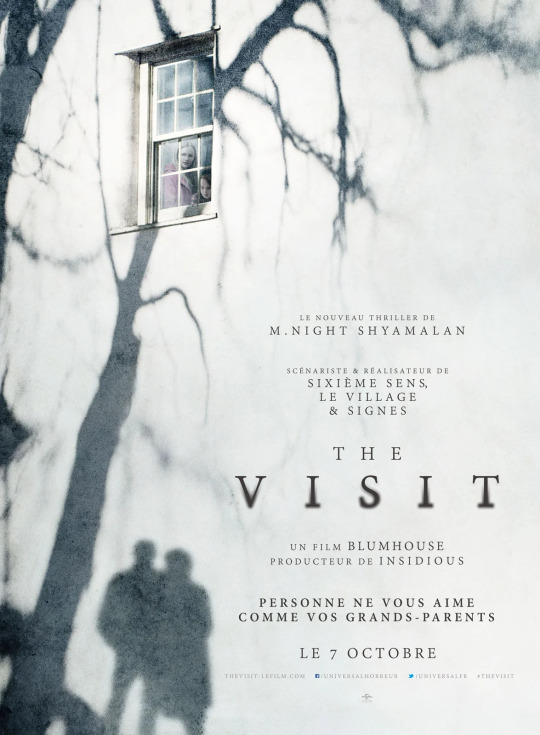
And let us conclude with... The Visit! Another movie by the very controversial M. Night Shyamalan, who produces among the best and worst movies we saw recently.
I haven't watched The Visit yet, though I plan to - but I have to include this because of how obvous the fairytale references and the fairytale theme is. Two children at sent by their mother to live with their estrange grandparents. The grandparents are nice and kind, though a bit strange, with bizarre rules and a possible start of dementia. However, the longer they stay there, the more the children start noticing a much more disturbing and dangerous behavior from their grandparents...
This movie is basically a real-life take on two fairytales intertwined together - Hansel and Gretel (with explicit references such as the grandmother asking the children to climb inside the oven to clean it) and Little Red Riding Hood (the same feeling of arriving at your grandmother's house only to realize there is something WRONG with your grandmother). And the whole thing comes with a final twist that actually clearly set this movie in the line of so many American urban legends such as "The killer on the backseat", "The old woman with hairy legs" or "The clown statue".
Ad what's a urban legend if not a modern-day fairytale? Or rather a modern day orror fairytale...
#spooky season fairytales#spooky season#fairytale horror#horror movies#dark fairytales#suspiria#inferno#texas chainsaw massacre#the visit#shining#the night of the hunter#psycho
19 notes
·
View notes
Text
'Patricia Highsmith’s 1955 novel The Talented Mr. Ripley has been made into two sterling films: 1960’s Plein soleil (Purple Noon) starring Alain Delon, and 1999’s The Talented Mr. Ripley headlined by Matt Damon, Jude Law, and Gwyneth Paltrow. Nonetheless, Netflix’s new Ripley stands head and shoulders above its predecessors (and most modern TV offerings) as an adaptation par excellence.
Over the course of its eight exhilarating episodes, all of them shot in breathtaking black-and-white by Oscar-winning cinematographer Robert Elswit (There Will Be Blood), this stellar thriller exhibits a formal precision, dexterity, and majesty that electrifies its tale of a small-time New York City grifter named Tom Ripley (a phenomenal Andrew Scott) who attempts to remake himself in Italy by slipping into the life of wealthy playboy Dickie Greenleaf (Johnny Flynn). Cunning cons and brutal murder ensue, all of them dramatized by the show with a suspenseful elegance and psychological complexity that does justice to its source material—and, in certain cases, adds new, incisive wrinkles to the oft-told tale.
Ripley is, quite simply, a small-screen masterpiece, and credit for its triumph goes, first and foremost, to writer/director Steven Zaillian. In the three decades since he won the Best Adapted Screenplay Oscar for Schindler’s List, the 71-year-old has collaborated with a who’s who of Hollywood greats, from Brian De Palma (Mission: Impossible) and Sydney Pollack (The Interpreter) to Ridley Scott (Hannibal, American Gangster, Exodus: Gods and Kings), David Fincher (The Girl with the Dragon Tattoo) and Martin Scorsese (Gangs of New York, The Irishman).
Along the way, he’s additionally penned the excellent Moneyball, helmed three of his own feature scripts (including the fantastic Searching for Bobby Fischer), and spearheaded HBO’s acclaimed The Night Of. Even with such a formidable résumé, however, Zaillian’s latest may be his finest achievement to date. Its scintillating style wholly wedded to its storytelling, and its meticulousness central to its simmering undercurrent of sociopathic madness, it’s a work of controlled Machiavellian malevolence, rife with tension and rich in detail and depth.
Guided by Zaillian’s virtuosic hand, Ripley is the rare example of genuine auteurist television, even as it simultaneously stands as a testament to the fact that projects are more likely to be great when they’re made by a collection of great artists. Now available on the streaming platform, it’s an early contender for end-of-year accolades. Consequently, we were elated to speak with Zaillian about the challenges of making his sensational series, collaborating with Scott and Elswit, and the enduring appeal of Highsmith’s famous novel.
Ripley is better directed than 99 percent of modern television, to a great degree because it’s been actually directed, with personality, flair, and guiding motifs and techniques. Was there any pushback to your approach, given that TV generally wants formal style to take a backseat to storytelling?
No, there was no pushback. The style that the show became… I started with the writing, I can’t write anything without imagining it. That being said, things obviously change when you’re shooting, and motifs come up and the style gets set at a certain point. But the whole time we were shooting, basically all anybody is seeing are dailies. It’s hard to tell from dailies what’s going on, you know [laughs]? Most people at the studios didn’t see anything until it was edited. So I had this great freedom to do what I wanted in terms of its look, and I spent a lot of time doing it. It was important to me that it looked good and felt good in terms of its tone, and most of the people who came to this come from film, and we approached it as one long movie.
Is the writing process different when you’re writing for yourself, versus another director?
I don’t write any differently. As I mentioned, I can’t write it without seeing it, so whether I’m writing for myself or someone else, it’s the same process. I don’t ever put in, close-up here or wide shot there. However, I do see it, so when I’m making my shot lists, I’ve already done it once before when I was writing it. But in terms of writing in a different way if someone else is going to direct it, no.
What made you want to tackle The Talented Mr. Ripley, which has been adapted multiple times before?
I’ve been wanting to do it since I read it, which I think was probably back in the ’80s. Certainly after Purple Noon but before The Talented Mr. Ripley movies. I saw it in a certain way and I wanted to try that, so when this opportunity came up, I took it. I just think it’s one of the great characters and one of the great stories that can be told over and over again.
What is it about the novel that’s allowed it to endure so powerfully over the past 70 years? Despite its age, it feels extremely relevant in today’s socio-political climate.
The idea of a character who becomes somebody else is something that happens all the time, today and throughout history. We’re strangely fascinated with it. I mean, it comes up all the time! There are articles—one that comes to mind from a few months ago was called “The Talented Mr. Santos.” I think this particular character is fascinating, certainly to me and I hope to other people. And the style of it—and I don’t mean the photographic style, but the style of the story—comes from Highsmith, where she finds these kinds of extraordinary things happening in normal circumstances with normal people. It’s something she’s well known for, and is something which I feel we can all relate to.
You’ve directed three feature films, but none since 2006. As a director, what compelled you to segue to television?
It’s the way things go. It’s strange to say that it’s easier to get a television show done than a movie, but it seems to be true, at least with the kinds of movies that I want to make. [TV] is a lot harder and it takes a lot longer, and I long for the days and the chance to make a movie again. I’m hoping that that’s what I’m going to do next, only because it won’t consume years and years of my time [laughs]. I can do the same thing and not have it take four or five years.
At what point did you decide to shoot the entire series in black and white, and what was your thinking behind that creative decision?
It started with the writing; that’s how I imagined it. Why, I don’t know. Maybe because of the period. I did want it to not feel like a postcard, and Italy, if shot in bright vibrant colors in the summertime with blue skies, can feel that way. I felt that this was a more dark and sinister story, not unlike a film noir story, and so black and white seemed to be the natural choice.
Yet despite that monochromatic scheme, you didn’t lose the classical beauty and romance of Italy.
You can’t lose that in Rome—it’s impossible [laughs]. Nor did I want to. But that being said, even a familiar place to people—like, well, you don’t really see the Coliseum except when he’s driving around with a corpse in the car—I didn’t want those places to be front and center. I wanted the backstreets of Rome more than the boulevards. Naples and Palermo are both really interesting places that photograph wonderfully in black and white.
But again, part of the story does take place on the Amalfi Coast, and that’s the place that’s hard to make sinister in color. When you have the aqua blue water and the bright sun, it’s tough. Luckily, we were at least filming there in the fall, so we didn’t have the brunt of tourism or those postcard shots, which certainly helped.
Robert Elswit shot the pilot of The Night Of and the entirety of Ripley. What is it about him as a cinematographer that makes your collaboration work so well?
It’s many things. Obviously, he’s really talented. He shoots beautiful movies. And we get along really well. He’s very intrepid—he’ll do anything, and go anywhere, and work crazy hours. He’s a workhouse in that regard. This took that kind of person. We shot for 160 days in Italy, with a one week break in the middle, and that’s tough on anybody. He just loved the idea of shooting it in black and white, and he’s a master with lighting, as you can tell when you watch it. It’s a great collaboration, we have.
The series is dominated by shots of Tom at a distance, framed in long claustrophobic hallways and by constricting architecture (such as the stairs of Dickie’s home in Atrani). Was it difficult to find the locations you needed for that visual style?
That’s one of those things when you talk about motifs… yes, I wrote a scene where Tom climbs a lot of steps, but that was a place that [production designer] David Gropman and I found. We drove from Salerno to Sorrento, all the way up the coast, and this little town called Atrani that has 800 people had those stairs, and I was fascinated by them. I said to David, it looks like an M.C. Escher drawing, and I found out much later that [Escher] had actually lived there and had drawn those very stairs. So that’s where it started. Then, wherever we went, we encountered stairs, and that’s when it started becoming a motif.
You shoot Tom’s two murders (and their aftermaths) in long, methodical sequences. Why was it important to stage those in such detail?
I had a little note scribbled on a Post-it when I started this saying, “It’s easier to kill somebody than it is to get rid of the body.” I wanted to show that. Even getting rid of a body that’s laying down in a little boat is hard to get rid of. I thought, this could be an opportunity to try something that I’d like to, which is showing these things in what feels like real time, and how difficult it is. I thought it was interesting, I thought it was entertaining, and I thought it was something I’d wanted to do from the beginning. So in the scripts, in episodes three and five, those sequences are about 35 pages long.
How did you settle on Andrew Scott for Tom?
I’d only seen him in three things, and one of them, I didn’t even see him; I’d only heard him—that was in a movie called Locke in which he did not appear, but he was a voice on the telephone. He created a really interesting character with just his voice. That was the first time I saw anything he was in. Then his Moriarty [in Sherlock] and Fleabag. With those three things, I felt he could do anything. They were so different from each other that I felt, that’s Tom. He’s got the range to play Tom.
Often in Ripley, the most important aspect of a given scene is what’s taking place beneath what’s being said aloud. From a writer’s standpoint, how do you tackle such undercurrents?
That’s always been important to me in the writing—to know, what is the point of the scene? Is it a piece of dialogue, is it an action, or is it the moments between the dialogue? Often, that’s where it is for me. Like you say, someone is lying and the other person knows they’re lying, and they play this kind of game with each other—that is the point of the scene! So those moments in-between the dialogue are what’s important. I spend a lot of time with that, and the actors got that, and they’re smart and they’re good and they like doing that. So in those instances, that was what was going on.
John Malkovich makes a late, brief appearance as Reeves, which is both a sly shout-out to Ripley’s Game (which he starred in, as Tom) and a tantalizing suggestion of future seasons. Was Malkovich’s participation always part of the plan—and was his cameo designed to keep the door open for a follow-up?
Both of those things are true. I wrote to him and explained that I’d like him to consider doing this. It’s very short, it’s just a couple of days, but maybe it’s a fun idea. And he thought it was and came to Venice and did it.
Yes, I was also thinking that if there’s another season, this character appears in the next two Highsmith books about Ripley, and he’s a great character. He does not appear in The Talented Mr. Ripley book; he doesn’t appear until the second book. But yeah, if that ever happens, I hope he’ll do it. Because he’s perfect for it.'
#Steven Zaillian#Robert Elswit#Patricia Highsmith#Matt Damon#Jude Law#Gwyneth Paltrow#Ripley#The Talented Mr Ripley#Andrew Scott#Locke#Sherlock#Fleabag#John Malkovich#Reeves Minot#Ripley's Game#David Gropman#Atrani#Moriarty#Netflix
3 notes
·
View notes
Text


An early photo of Lamar Smith and his wife Annie Clark Smith. Source: Collection of Mary Byrd Markham.
On August 13, 1955, Lamar Smith, 63-year-old farmer and WWI veteran, was shot dead in cold blood on the crowded courthouse lawn in Brookhaven, Mississippi, for urging African Americans to vote in a local run-off election. No one was prosecuted.
Smith, a locally known voting rights advocate affiliated with the Regional Council of Negro Leadership, had been threatened and warned to stop trying to register and organize African American voters in the community. These threats were realized when Smith was murdered on the courthouse lawn in front of dozens of witnesses, including Sheriff Robert E. Case, who permitted one of the alleged assailants to leave the crime scene covered in blood. Days later, that man and two others were arrested in connection with the shooting. All three suspects were white.
In September 1955, a grand jury composed of 20 white men declined to indict the three suspects for murder after witnesses failed to come forward to testify.

Pamphlet can be read online at the University of Mississippi.
Following the grand jury’s report, District Attorney E. C. Barlow criticized the lack of witness cooperation and complained about the sheriff’s handling of the case. Despite Barlow’s public promises to proceed with the investigation, the criminal case against the three suspects was dismissed. No one was punished for the crime.
Smith’s death was one of several racially-motivated killings in Mississippi that year, including the May 1955 murder of civil rights leader Rev. George Lee in Belzoni; the abduction and murder of Emmett Till in the Mississippi Delta in August 1955; and the fatal shooting of Gus Courts in Belzoni in December 1955. [Description by the Equal Justice Initiative: A History of Racial Injustice Timeline.]
Lamar Smith’s murder is listed in M is for Mississippi and Murder, a 1955 NAACP pamphlet that provides information about three racially-charged murders in Mississippi.
Learn more in the documentary film by Keith Beauchamp called “Murder in Black & White: Lamar Smith.” The film includes interviews with Jelani Cobb, Jerry Mitchell, Jaribu Hill, and Congressman Bennie Thompson.
#Mississippi#Brookhaven#M is for Mississippi and Murder#NAACP#Lamar Smith#lynchings#Murder in Black and White#1955#civil rights
11 notes
·
View notes
Text

The Emergence of Paul Pfeffer
Maggie Logan could not believe her eyes. Swaying unsteadily, as he beat his hands against the incoming surf and slowly regained his feet, the private detective took in the sight of playboy and fugitive from justice, Paul Pfeffer as he emerged from the sea. Retained by the Los Angeles Police Department to find the man suspected of murdering his millionaire wife, the red headed private eye had eventually gone on vacation in disgust, furious at her inability to even pick up the man’s trail, much less arrest him. And now, like mannah from heaven, the breathless, disheveled but very much alive, wanted man stumbled out of the ocean and onto the deserted beach, right in front of the woman who for three months had been unsuccessfully trying to find him so she could put Paul Pfeffer in jail. ‘Looks like mountains really do come to Mohammed after all,’ Maggie mused to herself.
Feeling undressed, not just by virtue of her swim suit, but also by the absence of her gun and handcuffs, the tough woman detective was not going to let this gift horse stumble on by and deny her her fee. Maggie stepped out from the beach rock she had just got changed behind and stood in front of the exhausted looking Paul, barring his path. “Hello, Mr Pfeffer,” she said casually, “nice day, isn’t it?” The tee shirted man shot her a look of confusion and alarm and then, before the detective could react, the fugitive had leapt on the woman, bowling her over until both tumbled into the sand. Pfeffer was strong - far stronger than he had any right to be, given how long he had been missing and his evident battle with the elements. And Maggie was still in holiday mode, quite unprepared for her quarry to almost swim into her lap. But now he was astride her, knees pressing the woman’s shoulders into the sand, his right hand raised with a rock clutched in it, ready to bring it down onto her skull.
“Wait!” Maggie called out. Her brain whirled, knowing that if she didn’t come up with something, this case could be her last. Bizarrely, the thought ‘I always thought I’d die with my boots on,’ drifted through her head, before the defeatist refrain was replaced by ‘Shoot, I haven’t even got my pantyhose on!’ and she was back to figuring a way out of this mess. Paul had indeed paused, the urgency in Maggie’s vouce making him stop to listen. “Paul you need to know - Carla’s nephew confessed to the murder!” the detective impressed on her attacker rapidly. “They fell out over the fact he stole her car and he brained her with a paper weight. The cops know it’s not you!” She looked up at Pfeffer as it dawned on the man that his months of hiding and avoiding all contact with the wider workd had been unnecessary. He was not going to the electric chair after all. “Oh thank god!” he breathed. The rock dropping from his grasp perilously close to Maggie’s face as it hit the sand with a soft thud. Paul’s face was in his hands as he wept in relief and exhaustion. Maggie wriggled out from under him and stood over the now kneeling, sobbing man. “But there is the small matter of the two million you embezzled from your late wife, sweetheart.” she told him. “You’re still under arrest.”
*
Maggie improvised and used a combination of the belt from her dress and her discarded tights to tie Paul’s hands behind his back. The man didn’t seem to mind at all. “What do you think I’ll get for the embezzlement charge, ma’am?” he asked Maggie as the female detective finished tying him and then took him by his elbow to trudge up to the road where her car was waiting,. “Seeing as you have effectively defrauded yourself now that your wife is dead, I’m not sure,” the red head smiled, “but with good behaviour, I’d be surprised if you serve eighteen months.” Paul breathed deeply. “Thankyou, ma’am.” he replied. “Thankyou so much.”
My interpretation of the story behind this cover to The Puzzle of Paul Pfeffer, Master Detective magazine (August 1955)
7 notes
·
View notes
Text
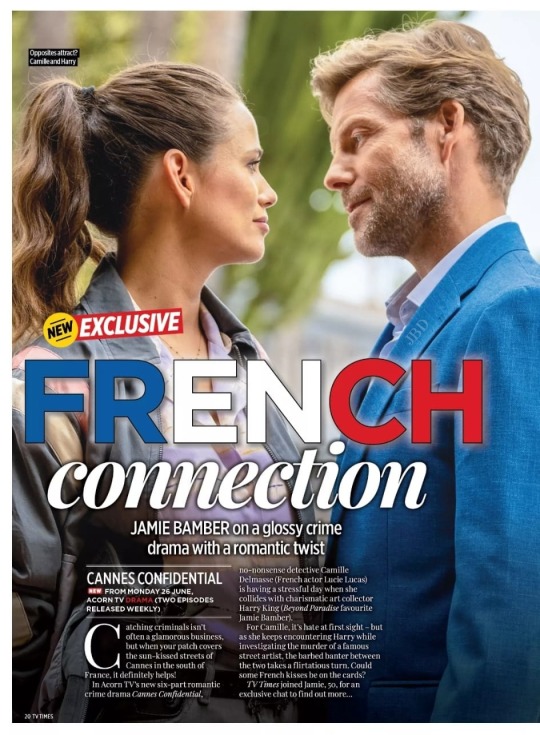
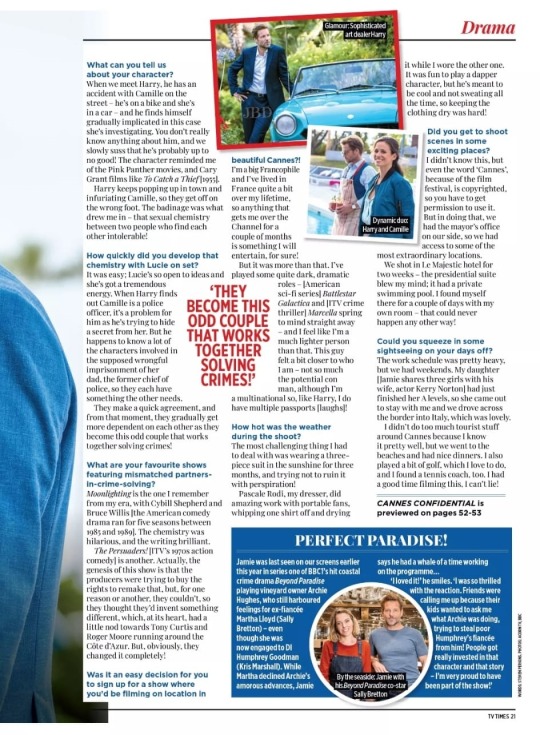
TV Times Interview - Issue 25 (24 - 30 June 2023)
Tap/Click ‘Keep Reading’ to view the transcript.
Catching criminals isn’t often a glamorous business, but when your patch covers the sun-kissed streets of Cannes in the south of France, it definitely helps! In Acorn TV’s new six-part romantic crime crime drama Cannes Confidential, no-nonsense detective Camille Delmasse (French actor Lucie Lucas) is having a stressful day when she collides with charismatic art collector Harry King (Beyond Paradise favourite Jamie Bamber). For Camille, it’s hate at first sight - but as she keeps encountering Harry while investigating the murder of a famous street artists, the barbed banter between the two takes a flirtatious turn. Could some French kisses be on the cards? TV Times joined Jamie, 50, for an exclusive chat...
What can you tell us about your character?
When we meet Harry, he has an accident with Camille on the street - he’s on a bike an she’s in a car - and he fins himself gradually implicated in this case she’s investigating. You don’t really know anything about him, and we slowly suss that he’s probably up to no good The character reminds me of the Pink Panther movies, and Cary Grant films like To Catch A Thief [1955]. Harry keeps popping up in town and infuriating Camille, so they get off on the wrong foot. The badinage was what drew me in - that sexual chemistry between two people who find each other intolerable!
How quickly did you develop that chemistry with Lucie on set?
It was easy; Lucie’s so open to ideas and she’s got tremendous energy. When Harry finds out that Camille is a police officer, it’s a problem for him as he;s trying to hide a secret from her. But he happens to know a lot of the characters involved in the supposed wrongful imprisonment of her dad, the former chief of police, so they have something that the other needs. The make a quick agreement, and from that moment, they gradually get more dependent on each other as they become this odd couple that works together solving crimes.
What are your favourite shows featuring mismatched partners-in-crime-solving?
Moonlighting is the one I remember from my era, with Cybill Shepherd and Bruce Willis [the American comedy drama ran for five seasons between 1985 an 1989]. The chemistry was hilarious, and the writing brilliant. The Persuaders! [ITV’s 1970 action comedy is another, Actually, the genesis of this show is that the producers were trying to buy the rights to remake that, but, for one reason or another, the couldn’t, so they thought they’d invent something different, which, at it’s heart, had little nods towards Tony Curtis and Roger Moore running around Côte d’Azur. But, obviously, they changed it completely!
Was it an easy decision for you to sign up for a show where you’d be filming in a location in beautiful Cannes?
I’m a big Francophile and I’ve lived in France quite a bit over my lifetime, so anything that gets me over the Channel for a couple of months is something I will entertain, for sure! But it was more that that. I’ve played some quite dark, dramatic roles - [American sci-fi series] Battlestar Galactica and [ITV crime thriller] Marcella spring to mind straight away - and I feel like I’m a much lighter person than that. This guy felt a bit closer to who I am - not so much the potential con man, although I’m a multinational so, like Harry, I do have multiple passports [laughs]!
How hot was the weather during the shoot?
The most challenging thing I had to deal with was wearing a three-piece suit in the sunshine for three months, and trying not to ruin it with perspiration! Pascale Rodi, my dresser, did amazing work with portable fans, whipping one shirt off and drying it while I wore the other one. It was fun to play a dapper character, but he’s meant to be cool and not sweating all the time, so keeping the clothing dry was hard!
Did you get to shoot scenes in some exciting places?
I didn’t know this, but even the word ‘Cannes’, because of the film festival, is copyrighted, so you have to get permission to use it. But in doing that, we had the mayor’s office on our side, so we had access to some of the more extraordinary locations. We shot in Le Majestic hotel for two weeks - the presidential suite blew my mind; it had a private swimming pool. I found myself there for a couple of days with my own room - that could never happen any other way!
Could you squeeze in some sightseeing on your days off?
The work schedule was pretty heavy, but we had weekends. My daughter [Jamie shares three girls with his wife, Kerry Norton] had just finished her A levels, so she came out and we drove across the border into Italy, which was lovely. I didn’t do too much tourist stuff around Cannes because I know it pretty well but we went to the beaches and had nice dinners. I also played a bit of golf, which I love to do, and I found a tennis coach, too. I had a good time filming this, I can’t lie!
PERFECT PARADISE
Jamie was last seen on our screens earlier this year in series one of BBC1’s hit coastal crime drama Beyond Paradise playing vineyard owner Archie Hughes, who still harboured feelings for ex-fiancée Martha Lloyd (Sally Bretton) - even though she was now engaged to DI Humphrey Goodman (Kris Marshall). While Martha declined Archie’s amorous advances, Jamie says he had a whale of a time working on the programme... “I loved it! he smiles. “I was so thrilled with the reaction. Friends were calling me up because their kids wanted to ask me what Archie was doing, trying to steal poor Humphreys fiancée from him! People got really invested in that character and that story - I’m very proud to have been a part of the show!”
3 notes
·
View notes
Text
Aleksandras Lileikis (10 June 1907 – 26 September 2000) was the chief of the Lithuanian Security Police in Vilnius during the Nazi occupation of Lithuania and a perpetrator of the Holocaust in Lithuania. He signed documents handing at least 75 Jews in his control over to Ypatingasis būrys, a Lithuanian collaborationist death squad, and is suspected of responsibility in the murder of thousands of Lithuanian Jews. After the 1944 Soviet occupation of Lithuania, he fled to Germany as a displaced person. Refused permission to immigrate to the United States because of his Nazi past, he worked for the Central Intelligence Agency in the early 1950s. In 1955, his second application for permission to immigrate was granted and he settled in Norwood, Massachusetts, becoming a naturalized citizen in 1976. Eli Rosenbaum, an investigator for the Office of Special Investigations, uncovered evidence of Lileikis' war crimes; proceedings for his denaturalization were opened in 1994 and concluded with Lileikis being stripped of his United States citizenship. [...]
He may have helped other Lithuanian Nazi collaborators obtain CIA jobs or immigrate to the United States.[18] In 1995, the CIA claimed that "there was no evidence that this Agency was aware of his wartime activities". This statement was described as a "gross distortion" by journalist Eric Lichtblau.[19]
In 1955, he applied again for permission to immigrate to the United States. Although the CIA passed negative information to United States immigration authorities, his application was accepted without explanation.[20][15] Lileikis' deputy, Kazys Gimžauskas, and three other subordinates also immigrated to the United States.[20] He settled in Norwood, Massachusetts and became a naturalized citizen in 1976.[1][21] Lileikis was involved in the Lithuanian community in the United States; he attended a Lithuanian Catholic church and worked as an administrator for a Lithuanian encyclopedia company [...] Historian Timothy Naftali notes, "the presence of this mass murderer in the general population sent a signal to fellow veterans of the secret police in Nazi-occupied Lithuania that Cold War America was forgiving of these murders".[18] [...]
In late 1982, Lileikis was mentioned in a cable from Berlin as a potential war criminal and head of the Lithuanian Security Police, who had possible connections to Einsatzkommando 3, part of the Einsatzgruppen. The same week, another Lithuanian-American named him as a Nazi collaborator in an interview. This attracted the attention of Eli Rosenblum, who was working as an investigator for the OSI. After gathering information on Lileikis, Rosenblum went to his residence to question him. Lileikis admitted his leadership of the Lithuanian Security Police, but denied his involvement in the killings, stating that he had only done routine security work. Lileikis claimed that he heard rumors that the Germans killed Jews at Ponary but that it was done without Lithuanian participation.[23]
In late 1994, the OSI opened civil denaturalization proceedings against him, seeking to strip Lileikis of his United States citizenship under Section 340(a) of the Immigration and Naturalization Act,[24] which requires United States district attorneys to open civil proceedings against naturalized citizens suspected of lying on their immigration paperwork.[25] At the time, Lileikis was the oldest person to be subject to such an action. The CIA tried to stop the case being filed, threatening not to allow the disclosure of some of the classified records in court.[26] Describing Lileikis as "one of the most important Nazi collaborators" to be investigated by the United States, OSI accused Lileikis of lying about his World War II activities on his immigration paperwork. Lileikis refused to comment on the allegations to the Associated Press and invoked the Fifth Amendment when questioned by prosecutors.[27][11] Lileikis refused to state even simple details on his life, such as his date and place of birth. Under federal law, the Fifth Amendment applies only to criminal proceedings; the prosecution argued that Lileikis should not be entitled to Fifth Amendment protection because he was not subject to criminal prosecution in the United States. The defense argued that Lileikis had a legitimate fear of prosecution in Lithuania, and should therefore not be compelled to testify.[28][29]
In 1995, Judge Richard Stearns of the United States District Court for the District of Massachusetts ruled that Lileikis was not entitled to Fifth Amendment protection because the government had a "legitimate need for a witness's testimony" in enforcing "the organic laws of the United States".[30][31] On 16 November, he granted the prosecution's motion to compel Lileikis' testimony; since he still refused to testify, the prosecution filed another motion on 18 December seeking that allegations which Lileikis refused to answer be admitted, as if Lileikis had confessed to them. This motion was granted by the court on 9 January 1996.[32] The Holocaust historian Yitzhak Arad and several other experts submitted affidavits along with more than a thousand pages of archival documents relating to the Nazi occupation of Lithuania, the Holocaust in Lithuania, and Lileikis' activities.[33] On 24 May 1996, Stearns found him responsible for the deaths of tens of thousands of Jews.[1][33] The judge noted that Lileikis was "attempting to turn the classic Nuremberg defense on its head by arguing that 'I was only issuing orders.'" Lileikis was immediately denaturalized[...]
Polish authorities indicated that he could face trial in Poland for the murders of Polish Jews in Vilnius.[34] Lithuania initially indicated that he would not be prosecuted due to the lack of eyewitnesses.[35][...]
Lithuania was slow to prosecute Lileikis. At the time, the country sought membership in NATO and the United States asserted that prosecution of Lileikis and other war criminals would be strong evidence of adherence to "western values," a prerequisite to joining the alliance. The message was relayed by the United States Vice President Al Gore during a meeting with the speaker of the Seimas in April 1997 and by thirty members of Congress in a November 1997 letter to the President of Lithuania.[37]
On 6 February 1998, Lileikis was charged with the crime of genocide by Lithuanian prosecutors.[1] It was the first Nazi war crimes prosecution in post-Soviet Eastern Europe.[38] He appeared in court in November 1998, but fainted just after few minutes and was taken away in an ambulance. Three special laws were passed in order to enable continuing prosecution of Lileikis and his former deputy Gimžauskas[1] (who had left the United States in 1995, facing denaturalization proceedings).[39] One of the changes allowed video evidence during genocide trials.[1] He was questioned over video on 23 June 2000 but after twenty minutes the proceedings were interrupted by an attending doctor and Lileikis was taken to a hospital.[40] The U.S. Department of Justice and Jewish organizations accused him of feigning illness.[21] The Simon Wiesenthal Center accused Lithuanian authorities of deliberately prolonging the trial in hopes that Lileikis would die of natural causes before he could be convicted.[21] The trial was well-publicized in Lithuania.[41] Lileikis died of a heart attack at Santara Clinics in Vilnius on 26 September 2000,[8] still insisting on his innocence and that he was the victim.[1][42] His funeral at the Vaiguva [lt] cemetery was attended by about a hundred people, including Mindaugas Murza, a radical nationalist.[2][43]
18 notes
·
View notes
Photo
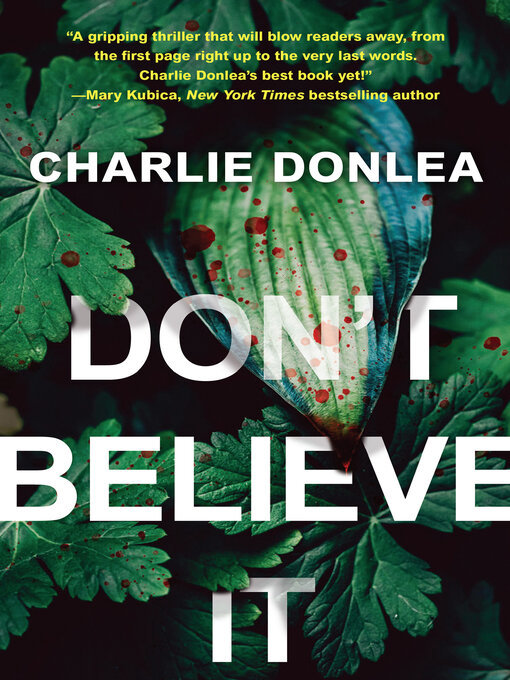
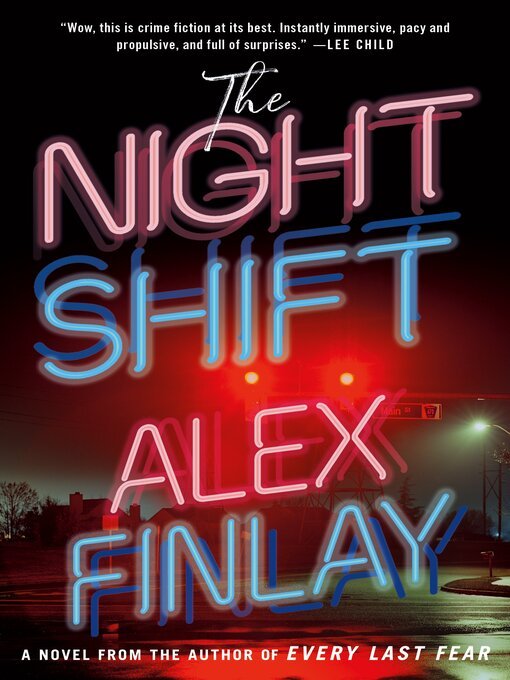
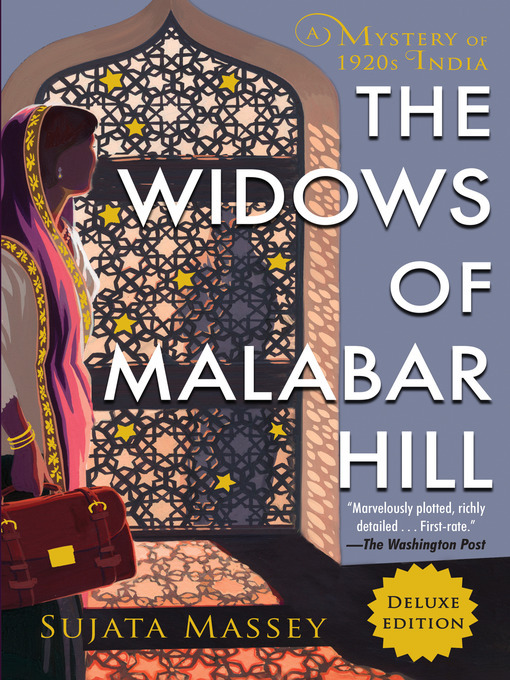
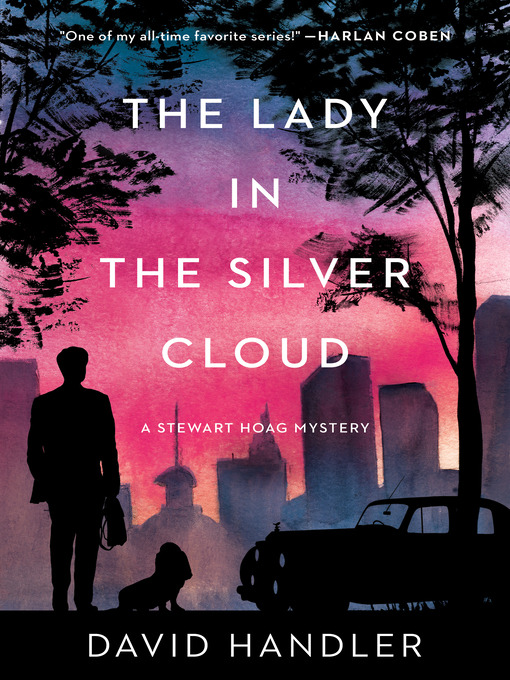
Libby Spotlight: Popular Mysteries
Don’t Believe It by Charlie Donlea
The Girl of Sugar Beach is the most watched documentary in television history—a riveting, true-life mystery that unfolds over twelve weeks and centers on a fascinating question: Did Grace Sebold murder her boyfriend, Julian, while on a Spring Break vacation, or is she a victim of circumstance and poor police work? Grace has spent the last ten years in a St. Lucian prison, and reaches out to filmmaker Sidney Ryan in a last, desperate attempt to prove her innocence.
As Sidney begins researching, she uncovers startling evidence overlooked during the original investigation. Before the series even finishes filming, public outcry leads officials to reopen the case.
Delving into Grace's past, Sidney peels away layer after layer of deception. But as she edges closer to the real heart of the story, Sidney must decide if finding the truth is worth risking her newfound fame, her career... even her life.
The Night Shift by Alex Finlay
It's New Year's Eve 1999. Y2K is expected to end in chaos: planes falling from the sky, elevators plunging to earth, world markets collapsing. A digital apocalypse. None of that happens. But at a Blockbuster Video in New Jersey, four teenagers working late at the store are attacked. Only one inexplicably survives. Police quickly identify a suspect, the boyfriend of one of the victims, who flees and is never seen again.
Fifteen years later, more teenage employees are attacked at an ice cream store in the same town, and again only one makes it out alive.
In the aftermath of the latest crime, three lives intersect: the lone survivor of the Blockbuster massacre who's forced to relive the horrors of her tragedy; the brother of the fugitive accused, who's convinced the police have the wrong suspect; and FBI agent Sarah Keller who must delve into the secrets of both nights—stirring up memories of teen love and lies—to uncover the truth about murders on the night shift.
The Widows of Malabar Hill by Sujata Massey
Bombay, 1921: Perveen Mistry, the daughter of a respected Zoroastrian family, has just joined her father's law firm, becoming one of the first female lawyers in India. Armed with a legal education from Oxford, Perveen also has a tragic personal history that makes her especially devoted to championing and protecting women's rights.
Mistry Law is handling the will of Mr. Omar Farid, a wealthy Muslim mill owner who has left three widows behind. But as Perveen goes through the papers, she notices something strange: all three have signed over their inheritance to a charity. What will they live on if they forefeit what their husband left them? Perveen is suspicious.
The Farid widows live in purdah: strict seclusion, never leaving the women's quarters or speaking to any men. Are they being taken advantage of by an unscrupulous guardian? Perveen tries to investigate and realizes her instincts about the will were correct when tensions escalate to murder. It's her responsibility to figure out what really happened on Malabar Hill, and to ensure that nobody is in further danger.
This is the first volume in the “Perveen Mistry” series.
The Lady in the Silver Cloud by David Handler
A 1955 Rolls-Royce Silver Cloud is a fantastically expensive car, especially in the pristine condition of the one owned by Muriel Cantrell. Living in a luxury apartment building on Central Park West, the delicate, sweet 75-year-old woman is a neighbor of Merilee Nash, the beautiful movie star, and Stuart Hoag, whose first book was a sensation but whose career crashed when he became involved with drugs and alcohol. Divorced ten years earlier, Hoagy has been welcomed back into Merilee's life and apartment.
Apparently universally beloved in her building, residents are shocked when Muriel is murdered after a Halloween party. No one takes it harder than her long-time chauffeur, Bullets Durmond, whose previous job was as an enforcer for the mob. Who in the world would want to harm the silver-haired lady whose major vices were buying shoes and Chanel suits (always in cash), and watching day-time soap operas?
Lieutenant Romaine Very of the NYPD is called to investigate and again seeks help from his friend Hoagy who, along with his basset hound Lulu, has been an invaluable aide in the past. The investigation leads to the unexpected source of Muriel's wealth, the history of her early years as a hatcheck girl at the Copacabana, how her chauffeur came to be called Bullets, her desperate meth-head nephew, and her wealthy neighbors, who have secrets of their own.
This is the 13th volume in the “Stewart Hoag” series.
#mystery#mysteries#mystery books#murder mystery#Libby#ebooks#Library Books#Book Recommendations#book recs#Reading Recs#reading recommendations#TBR pile#tbr#tbrpile#to read#Want To Read#Booklr#book tumblr#book blog#library blog
4 notes
·
View notes
Text
DESILU DOG POUND
Canine Companions on Lucycoms!

Woof! Open the kennels and take a look at all the dogs, pups, and canine pets in the Lucyverse!

In Annabel Takes a Tour (1938), Annabel (Lucille Ball) has a Terrier named Elmer.
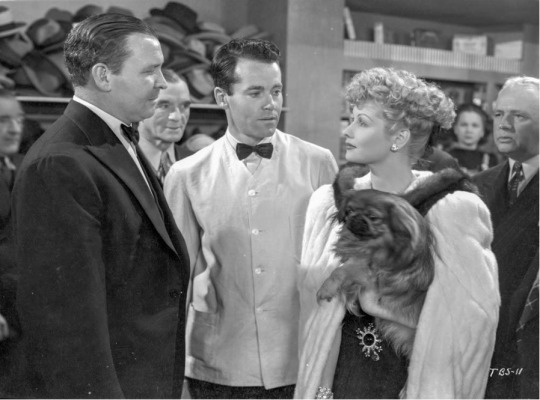
In The Big Street (1942), Gloria Lyons (Lucille Ball) has a lap dog she calls Baby. Pinks (Henry Fonda) rescues Baby from being run over by a car.

Probably one of the most famous dogs on television was Fred the dog. Little Ricky's friend Billy Palmer gave him a puppy to take home in January 1957 and he became part of the Ricardo family. Landlord Fred Mertz tells Lucy and Ricky their lease prohibits pets, but he bends the rules when Little Ricky names his puppy Fred.
LITTLE RICKY: “I always name my pets after people I like.”
Fred the dog was played by a Cairn Terrier named was Danny. He was trained by Bob Blair and was owned by Frank Inn. Danny also played Fremont, Mr. Wilson's dog on "Dennis the Menace" (1959-63). In films, he was Snuffy in Pal Joey (1957), Muffy in Anatomy of Murder (1959), and Pepe in the final Three Stooges short Sappy Bullfighters (1959). Fred the dog would make the move to Connecticut with the Ricardos, but is not seen or mentioned during “The Lucy-Desi Comedy Hour” episodes. While he was the most popular, Fred was not the only dog seen on “I Love Lucy”...
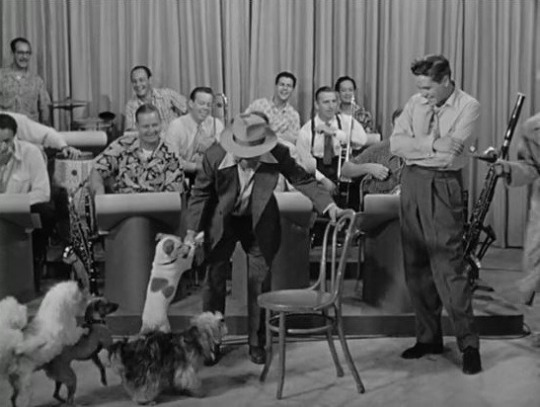
At the end of “Lucy Thinks Ricky is Trying to Murder Her” (1951), the very first episode of “I Love Lucy” filmed, a dog act makes an appearance. An established vaudeville act, Hector and His Pals was also seen in the film Easter Parade in 1948. The dog trainer Hector, calls one of the dogs by its real name ‘Yorkie’. In the episode, the dogs are named Ann, Mary, Helen, Cynthia, Alice, and Theodore. Lucy hears the dogs’ names and thinks they are women Ricky is having an affair with - until she hears Theodore!
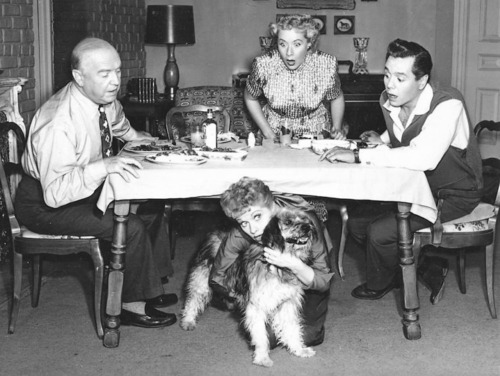
In the third episode aired, Butch, Fred’s mutt (as far as we can guess) stays under the table hoping for scraps in “The Diet” (1951) and then never heard of again. Unbeknownst to the others, a starving Lucy crawls under the table with Butch to intercept any tasty morsels meant for the dog.

Butch looks quite alarmed by the crazy lady under the table!

Sneaking into Richard Widmark’s mansion in “The Tour” (1955), Lucy hides under a bear rug - which just happens to be the favorite spot of Widmark’s St. Bernard Cap.
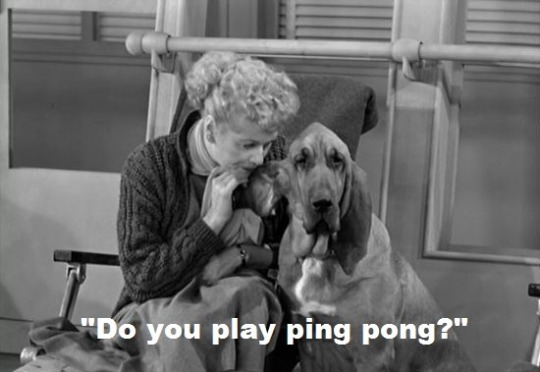
In “Second Honeymoon” (1956), a lonely Lucy asks Rocky the Bloodhound if he wants to play ping pong. Randy Rocky is tempted away by a French Poodle on a stroll.

Lassie, the most famous canine in Hollywood history, turned up on “The Desilu Revue” in 1959. The series was filmed at Desilu Studios. Lucy and Desi enlisted the participation of all the Desilu stars in their Christmas special. Lassie was first mentioned by Lucy Ricardo in “The Young Fans” (1952).

In the very first episode of “The Lucy Show” in 1962, Tiger the dog belongs to Lucy's neighbor and boyfriend Harry Connors (Dick Martin), who we will meet in episode two. A dog named Tiger was also featured on TV's “The Brady Bunch” (1969-1974). Here Tiger serves more as a plot device than pet. This is his one and only appeareance on the series.
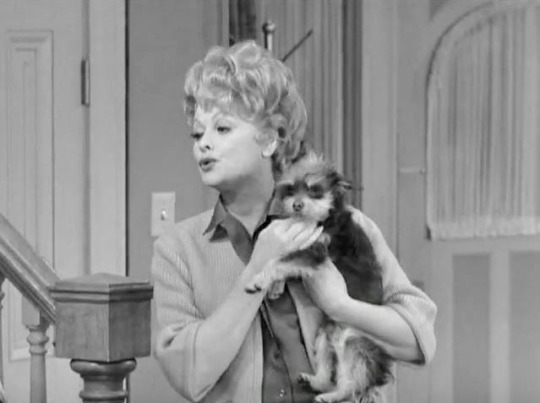
When “Lucy and Viv Learn Judo” (1963), the Carmichaels dogsit with Alvin, played by Hey! The dog belong’s to Jerry’s friend Amy Schaffer.

The final scene of the episode features a dozen dogs of various breeds, who come running at the silent sound of a dog whistle!
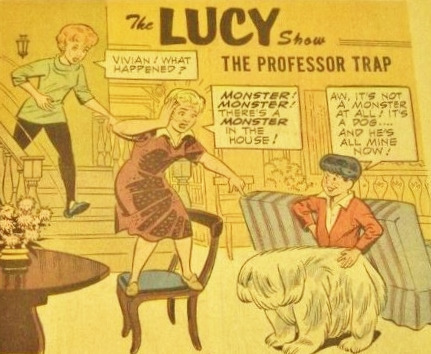
In the first frame of the June 1963 “The Lucy Show” Gold Key comic book, Jerry brings home a shaggy dog which Viv mistakes for a monster!

“Kiddie Parties Inc.” (1963) features Thunderbolt, a basset hound with more folds than an oragami swan.

In “Lucy is Her Own Lawyer” (1964) ~ Lucy complains when Mr. Mooney’s barking sheepdog Nelson (played by Lord Nelson) keeps her up all night. He tells her to sue him, and she does. After making a mockery of the court proceedings by acting as her own attorney, she finally wins her case by cross-examining Nelson. The neighborhood canines include:
Howard McAdams’ Pomeranian
Audrey Simmons’ Beagle
Grandma Sutton’s Airedale
The Hamilton’s Police Dog
Nelson is the only dog to appear on screen, with voice actor Pinto Colvig providing the off-screen barks for the other dogs.

Lord Nelson (Nelson) makes his first appearance as Mr. Mooney’s dog. He will also appear in “Lucy’s Contact Lenses” and would go on to appear on “Here’s Lucy” as Bogie in “Lucy and the Bogie Affair”. From 1965 to 1967, he played Ladadog (aka Lad) on “Please Don’t Eat the Daisies” and reprised the role of Nelson on “The Doris Day Show” from 1968 to 1971.

To keep Nelson in check, dog trainer Bob Blair plays the Bailiff.

In “Lucy and Clint Walker” (1965) Lightning, a lethargic Basset Hound, has a propensity to fall asleep, much like his master did Frank Winslow (Clint Walker) in “Lucy and the Sleeping Beauty”.
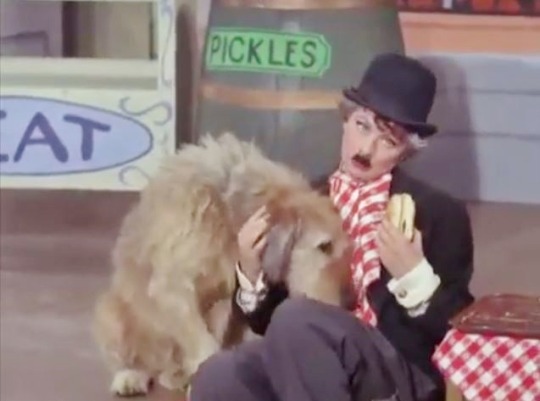
“Lucy Meets Mickey Rooney” (1966) has Lucy playing Charlie Chaplin in an acting school recital. The sketch features a mutt befriending the Tramp for his sandwich.
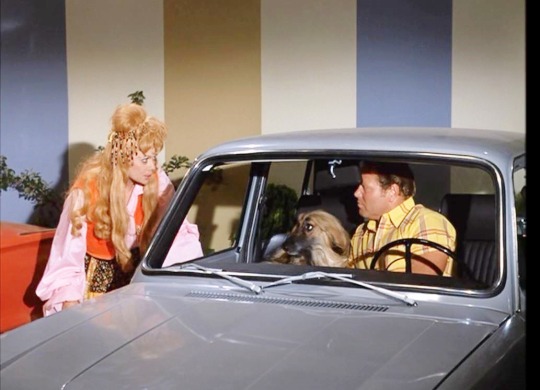
“Lucy at the Drive-In Movie” (1969) has Lucy searching through the passion pit cars for Kim and her new boyfriend. She mistakes an Afghan Hound for a long-haired woman.
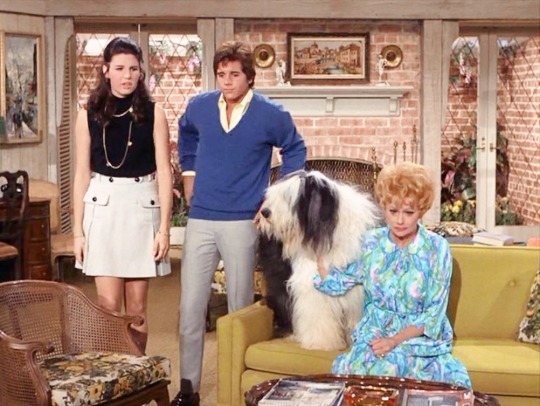
In “Lucy and the Bogie Affair” (1969) Kim and Craig bring home a stray sheepdog (played by Lord Nelson) which they call Bogie because it has the same sad look standing in the rain as Humphrey Bogart does at the end of 1942's Casablanca.

When Bogie turns out to be a she and gives birth to a litter of puppies, the Carters must find a home for the baby Bogies.
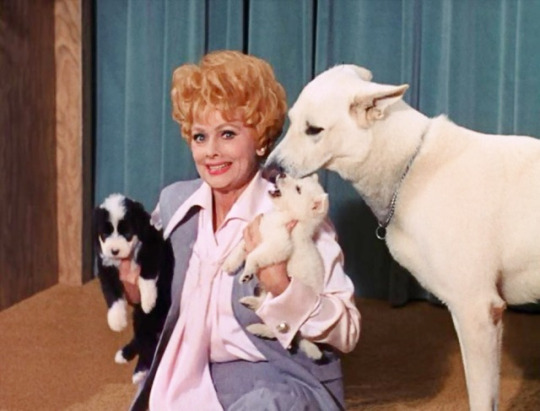
Lucy tries to give one of the pups to exercise guru Jack LaLanne, but only ends up taking one of Happy’s pups. Happy was LaLanne’s real-life dog appearing with him on many of his television shows.
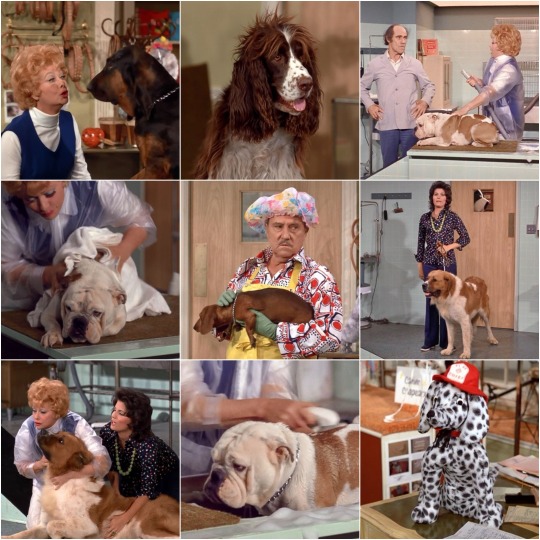
“The Bow-Wow Boutique” (1973) has Lucy, Kim and Harry opening a dog grooming business. Their clients include:
Louie, a French Spaniel
Winston, a Bloodhound
Teddy, an English Bulldog
Tiger, a Yorkshire Terrier
Tinkerbell, a St. Bernard
and an un-named Daschund
LUCY THE PUP






#Lucille Ball#Dogs#Pups#Puppies#Canine#I Love Lucy#The Lucy Show#Here's Lucy#Gale Gordon#Lucie Arnaz#Desi Arnaz#Vivian Vance#William Frawley#Lassie#Desi Arnaz Jr.#Jack LaLanne#Keith Thibodeaux
5 notes
·
View notes
Text
A "lost" Orson Welles film
youtube
From the 1955 feature 'Three Cases of Murder'. This is the third & final episode: "Lord Mountdrago", from Somerset Maugham's story.
Hired only as an actor, Welles quickly took over the direction - the nightclub sequence is indisputably his work.
0 notes
Photo

Emmett Louis Till (July 25, 1941 – August 28, 1955) was a 14-year-old African American who was lynched in Mississippi after being accused of offending a white woman in her family's grocery store. The brutality of his murder and the fact that his killers were acquitted drew attention to the long history of violent persecution of African Americans in the US. He posthumously became an icon of the civil rights movement. He was born and raised in Chicago. During summer vacation in August 1955, he was visiting relatives near Money. He spoke to 21-year-old Carolyn Bryant, the white married proprietor of a small grocery store there. Although what happened at the store is a matter of dispute, he was accused of flirting with or whistling at her. She testified that he made physical and verbal advances. She disclosed that she had fabricated part of the testimony regarding her interaction with him, specifically the portion where she accused him of grabbing her waist and uttering obscenities; "that part's not true," she stated in a 2008 interview. She said she could not remember the rest of the events that occurred between her and him. She said: "nothing that boy did could ever justify what happened to him". His interaction with her, perhaps unwittingly if at all, violated the strictures of conduct for an African-American male interacting with a white woman. Several nights after the incident in the store, her husband and his half-brother were armed when they went to his great-uncle's house and abducted him. They took him away and beat and mutilated him before shooting him in the head and sinking his body in the Tallahatchie River. Three days later, his body was discovered and retrieved from the river. In June 2022, an unserved arrest warrant for Carolyn Bryant dated August 29, 1955, and signed by the Leflore County Clerk was discovered in a courthouse basement by members of the Emmett Till Legacy Foundation. Following the discovery, his family called for Bryant's arrest. The district attorney declined to charge Carolyn as she said that there was no new evidence to open the case back up and Emmett’s family reacted negatively. #africanhistory365 #africanexcellence https://www.instagram.com/p/CgbsXNruB6yFapql21ELCfpyrl6ymzIPjo-9Xw0/?igshid=NGJjMDIxMWI=
0 notes
Photo




Joseph Schuyler | Toni Morrison’s Play “Dreaming Emmett”, The Capital Repertory Theatre in Albany, New York, 1985
“The idea for ''Dreaming Emmett'' came to Miss Morrison two years ago, before she went to Albany. It was conceived, she said, ''not as a novel, or an essay, but as a play. I wanted to see a collision of three or four levels of time through the eyes of one person who could come back to life and seek vengeance. Emmett Till became that person.''
There are these young black men getting shot all over the country today, not because they were stealing but because they're black,'' she said. ''And no one remembers how any of them looked. No one even remembers the facts of each case. Certain things were nagging at me for a long time -the contradictions of black people, the relationships between black men and women, between blacks and whites, the differences between 1955 and 1985.”
These are among the questions Miss Morrison raises in her play in a complex nonnaturalistic form. The characters and the action shift back and forth in time and place, and there is a play within a play. The nonlinear story involves an anonymous black boy who was murdered. In a dream state he suffers the pain of remembering his death 30 years before. Seeking revenge and a place in history, he summons up the perpetrators of his murder, as well as his family and friends, all to be characters in his dream. But his ghosts refuse to be controlled by his imagination; all see the past in their own way, as the boy doggedly searches for a meaning to his death - and thereby his life. At one point he is challenged by a member of his imaginary audience, a black woman who rejects his dream and provokes a confrontation on sexual issues.
The play as a whole raises questions about history. Can the murder of a Mississippi boy 30 years ago be a shared collective nightmare of the American soul, black and white? Is the past too different from the present for any generation ever to perceive the past? Is history a ''dream'' that produces only ambiguity and forgetfulness?
Margaret Croyden, The New York Times, December 29th, 1985
Full article: https://www.nytimes.com/1985/12/29/theater/toni-morrison-tries-her-hand-at-playwriting.html
Images: https://collaborativemagazine.org/2020/01/22/toni-morrison-dreaming-emmett-albany/
#Toni Morrison#Emmett Till#Joseph Schuyler#black history#plays#playwright#Peformance#black culture#black life#black writers#photography#1980s#bw
90 notes
·
View notes
Photo


From Emmett Till to Pervis Payne — Black Men in America Are Still Killed for Crimes They Didn’t Commit By Daniele Selby of the Innocence Project
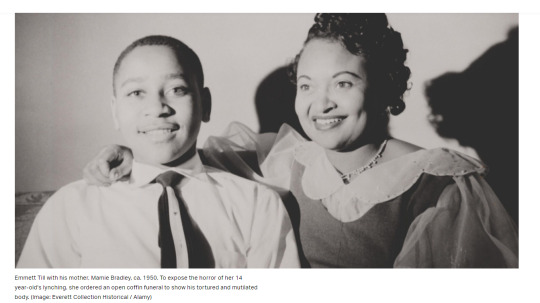
Emmett Till, a young Black boy in Mississippi, turned 14 on July 25, 1955. Almost exactly one month later, he was brutally murdered after being accused of sexually harassing Carolyn Bryant, a white woman, in a grocery store.
Till would have turned 79 today had he not been killed. The two white men accused of his murder were later found “not guilty” by an all-white, all-male jury. Four months after the trial, which took place in a segregated courtroom, the two men admitted to kidnapping and murdering Till in an interview with Look magazine. Because they had already been acquitted, they could not be tried again. Neither ever served time for Till’s death.
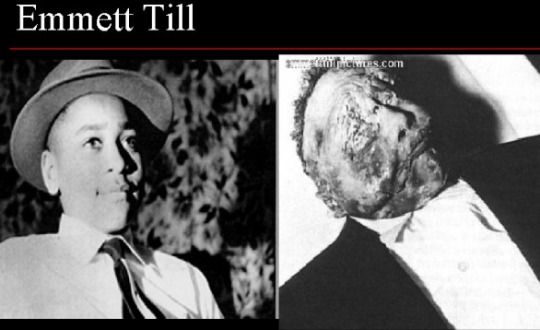
Six decades later, Bryant admitted that she had lied and that the parts of her accusation considered most incendiary at the time — that Till had grabbed her and made verbal and physical advances on her — were untrue. Bryant has never faced any legal consequences for her accusations against Till. The FBI opened a reinvestigation into his murder three years ago.
These are the same kind of racist stereotypes that the prosecution in Pervis Payne’s case evoked at trial to convict him of murder. Payne, who has an intellectual disability, has spent 32 years facing execution in Tennessee for a crime he has always said he did not commit — and DNA testing of evidence in his case could help prove this. The Innocence Project jointly filed a petition for DNA testing on July 22.
Payne was convicted for the 1987 murder of Charisse Christopher and her child in Millington, Tennessee. The prosecution argued that Payne had been searching for sex after using drugs and looking at a Playboy magazine, and that he attacked Christopher after he made an advance on her and she rejected him. But no evidence supports this theory.

But the prosecution painted a very different picture, making Payne out to be a violent and hypersexual drug user. And, at trial, the prosecutor repeatedly pointed out the victim’s “white skin” when referring to parts of her body, a poignant reminder of her whiteness in a county ranked among the 25 counties with the most recorded lynching's between 1877 and 1950, according to the Equal Justice Initiative.
In the late 1800s, claims that Black men had raped or made sexual advances on white women were frequently cited to justify their lynchings. Historians say that in reality many rape accusation claims were false and were often used as cover for consensual relationships that were, at the time, extremely taboo.
And racist beliefs were so deep-seated among white communities, that “Whites could not countenance the idea of a white woman desiring sex with a [Black person], thus any physical relationship between a white woman and a [B]lack man had, by definition, to be an unwanted assault,” writes historian Philip Dray.
The perception of Black men as a danger to white women in particular, contributing to false accusations like the ones lobbied against Till and the Scottsboro Boys, is deeply rooted in this history and the legacy of slavery. In Louisiana, for instance, rape was only considered a crime when the victim was a white woman, according to the American Bar Association, and capital punishment was a mandatory punishment for rape and attempted rape only when the alleged attacker was a slave (and Black).
In Alabama, the court allowed juries to consider a defendant’s race and to rely on social stereotypes about that race — like the prevalent belief at the time that Black men are prone to raping women — to infer the defendant’s intent to commit a crime.
Today, Black men are twice as likely to be arrested for a sex offense and three times more likely to be accused of rape than white men, the Appeal reported. That’s not because they are committing such crimes at higher rates than people of other races or ethnicities, but because they are more often suspected and accused of such crimes due to racial biases. EXCEPT TAKEN FROM The Innocence Project
*WHITE LIES AND BLACK LYNCHINGS*
Though the exponential increase in lynching did not truly begin until the late 1880s, the upward trend had already begun a decade earlier. Casual articles with headlines like A Rascal Lynched' were fairly common in the newspapers of the 1870s; already, much of the Southern public was blinded with fear and rage at the idea of a black man with a white woman.
A lynching was most likely to occur in cases where a black man had been convicted of ;outraging' (raping) a white woman, though a lack of conviction did not mean whites presupposed an accused negro's innocence. In Cairo, Mississippi, for example, a black man arrested for attempted rape of a white girl was taken from the jailhouse; by a number of citizens and hanged.
Threats of extralegal executions for black men were accepted as almost normal when a white woman's integrity and supposed virginity were at stake; many newspaper accounts failed to even mention the suspect's name.

By the last decade of the nineteenth century, lynching had become the ultimate public expression of white male dominance, complete with cameras, newspaper announcements, and special excursion trains chartered for urban whites to view the ritual and extended torture of African-American men and even women in rural areas. EXCERPT TAKEN FROM: Lynching to Protect White Women from
Rise And Fall of the Slave South, University of Virginia
*WHITE LIES AND BLACK LYNCHINGS IS PART OF THE SERIES * PURE EVIL
*in future post to come more in-depth information and stories on the pure evil of lynching and the injustice of the unjust legal system for blacks*
Black Paraphernalia disclaimer - images from Goggle Image
#Black Paraphernalia#pure evil#lynching in america#emitt till#same story different day no change#this is america#ahmaud arbery
42 notes
·
View notes
Text
CHRONOLOGY OF AMERICAN RACE RIOTS AND RACIAL VIOLENCE p-6
1994
Survivors of the Rosewood, Florida, riot of 1923 receive reparations.
February Standing trial for a third time, Byron de la Beckwith is convicted of murdering civil rights worker Medgar Evers in June 1963.
1995
In the Cato v. United States decision, the Ninth Circuit Court of Appeals denies African Americans $100 million in reparations and an apology for slavery.
1996
August A federal indictment is handed down against the Ku Klux Klan, which was charged with arson in the burning of more than seventy African American churches in South Carolina.
1997
Oklahoma Legislature creates the Tulsa Race Riot Commission to document and make reparation recommendations regarding the 1921 Tulsa riot.
Debut of the movie Rosewood about the riot in Rosewood, Florida, in 1923.
1998
June Three white men in Jasper, Texas, murder James Byrd, Jr., an African American man, by dragging him behind a truck for three miles.
2000
Representative Tony Hall proposes bill H.R. 356, which would acknowledge and apologize for slavery; the measure does not pass.
2001 April Cincinnati, Ohio, riot.
2002
March Jamil Abdullah Al-Amin (formerly H. Rap Brown) is found guilty of shooting two white deputies and is sentenced to life in prison.
2003
Debut of Stanley Nelson’s film, The Murder of Emmett Till, about the death of a black Chicago boy in Mississippi in 1955.
2004
Survivors of the 1921 Tulsa, Oklahoma, riot receive reparations.
2005
September U.S. Senate passes the Unsolved Civil Rights Crimes Act (known as the ‘‘Till Bill’’), forming a new federal unit within the Civil Rights Division of the Justice Department to investigate and prosecute unsolved civil rights–era murder cases
2 notes
·
View notes
Photo

Three Cases of Murder
directed by David Eady, George More O’Ferrall, Wendy Toye, and Orson Welles, 1955
#Three Cases of Murder#The Picture#You Killed Elizabeth#Lord Montdrago#David Eady#George More O'Ferrall#Wendy Toye#Orson Welles#movie mosaics#Hugh Pryse#Emrys Jones#Eddie Byrne#Alan Badel#Helen Cherry#John Gregson#Elizabeth Sellars
9 notes
·
View notes
